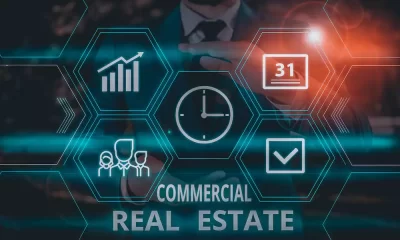Management
Commercial Landlords Tips To Attract Office Tenants

Office building owners know they need to be flexible, responsive, and proactive in addressing the changing needs of tenants in the post-pandemic environment.
It was the COVID-19 pandemic that dramatically affected the commercial real estate market, especially the office space sector.
Post-pandemic it’s been impossible for companies to get their staff back to the office full-time. Many companies have accepted the ‘new normal’ of hybrid working – splitting the week between working in the office and remotely at home.
Most businesses now need much less office space, and with meagre rent rises in 2023, landlords need to think outside the box to attract commercial tenants to their retail office space.
Offices and Office Buildings
Taking too long to move with the times has caught many owners of offices and office buildings out. They now struggle to hang onto their assets in 2023.
Sadly, some office landlords have made the tough call to quit, pulling the plug when it’s time to bring their assets up to standard or repurpose them. Cutting their losses can result in selling, which can take too long in a buyer’s market. When there is no other way out, owners of commercial office space hand the keys to lenders who can sell the asset to cover their client’s liability – i.e., recoup the loan principle and selling fees.
A survey by MBA.org confirms the office market is the most volatile of sectors. Therefore, it’s fair to say current activity should warn new commercial investors to choose their type of commercial real estate carefully.
When offices are preferred over other commercial property sectors, the investor must choose the best location with higher occupancy rates.
Location Is Almost Everything
For offices, location has always played a significant role in attracting tenants.
London
There are pockets of optimism in some locations like London, where commercial office rents are expected to increase by 1.6%. This isn’t too far off the forecast rent increase overall for all commercial property of 2% by 2026.
New York
In New York, similar optimism where Statista reports renting and leasing activities in New York forecast an annual growth rate of 1.71% for 2023 – 2024. According to WSJ, rents increased by just 1.6% during 2019 – 2022.
The good news is rents are rising; however, while inflation is up and loan interest rates are increasing, profit is squeezed more than usual.
Avoid Dropping The Rent
Please don’t drop the rent, as it directly impacts property value. If you have an office building with many tenants – lowering the rent for one affects the value of the building as a whole.
In WSJ – Michael Pan of Carter Jonas says:
If the headline rent is decreasing capital values will fall
You can avoid dropping the rent rate but provide a perk that is sure to win over tenants sitting on the fence.
Offer Perks
Some of the more commonly used perks to secure leases include:
- Rent abatements
- Rent-free period
- Fit-out contribution
Rent Abatement
Rent abatement is a temporary suspension or reduction of rent payments granted by a landlord to a tenant.
In commercial leasing, rent reduction can be granted to tenants in cases where their ability to operate their business in the leased space is affected by circumstances beyond their control, such as construction, repairs, or natural disasters.
Covid-19 was considered an event where rent abatement was granted by landlords, with nations’ governments insisting on it during lockdowns.
Examples
An example of rent reduction for a commercial tenant might be when a tenant’s store is flooded due to a burst pipe in the building, rendering the space unusable for a certain period. In such a scenario, the landlord might agree to reduce or waive the tenant’s rent payments for the repair and cleanup period.
Another example might be a situation where the landlord is carrying out significant renovations in the building, which makes it difficult or impossible for the tenant to conduct business as usual. In this case, the landlord might agree to reduce or waive the tenant’s rent payments for a specific time to compensate for the inconvenience and lost income.
It’s worth noting that the specifics of rent reduction will vary depending on the lease agreement terms and the situation’s circumstances.
Rent-free time
According to the office property management company, Derwent London, on a 10-year lease, up to 20% of the term can be rent-free. That equates to an incredible two years (i.e., 24 months rent-free). However, this is London, UK.
In the USA, the rent-free period is not so generous. 20% in the UK is just circa 6% (7.5 months) of the lease term. That’s attractive, and I’m sure many residential tenants would love this incentive included in their tenancy agreement.!
Fit-out contribution
It’s not uncommon for landlords to contribute to tenant improvement costs.
The amount that landlords contribute to a tenant’s office fit-out can vary widely depending on several factors, such as:
- Location of the property
- Quality and age of the building
- Length of the lease
- Rental market conditions
A landlord may offer a tenant a fit-out allowance, which is a sum of money that the tenant can use to cover the costs of their fit-out. The allowance amount may be a fixed sum or a percentage of the total cost of the fit-out.
There is no fixed or usual amount that landlords contribute to a tenant’s office fit-out. Ultimately, a landlord’s contribution depends on the negotiations between them and the tenant.
Tenants must thoroughly research the market conditions and be prepared to negotiate to secure the best deal possible.
Standard Upgrades
Upgrading your office building to attract commercial tenants requires standard upgrades that may need extra funds to include:
- Health and safety measures
- Technology upgrades
- Amenities
- Flexible leasing options
Health and safety measures
Building owners are implementing new health and safety protocols to make their properties more attractive to potential tenants. This includes enhanced cleaning and disinfecting procedures, air filtration systems, and touchless technology.
Technology upgrades
The pandemic has highlighted the importance of technology in the workplace, and many office building owners are investing in technology upgrades to attract tenants. This includes high-speed internet, intelligent building systems, and video conferencing capabilities.
Don’t forget security. Commercial spaces that are secure from intruders are more attractive to commercial tenants. Cameras, alarms, and panic buttons are some of the features needed so tenants can ensure their staff are safe in the office, particularly outside usual office hours.
Amenities
Building owners are now also focusing on amenities that will make their properties more appealing to tenants. When it is a buyer’s market, there are more properties to choose from. Landlords in the know will do whatever they can to stand out and secure long-lease tenants. While it will dent your pocket, update your building by adding a fitness centre, outdoor spaces, bike storage, and food and beverage options.
Flexible leasing options
Many office building owners are offering more flexible leasing terms to attract tenants. This includes shorter lease lengths and flexible options such as shared office spaces and co-working arrangements.






